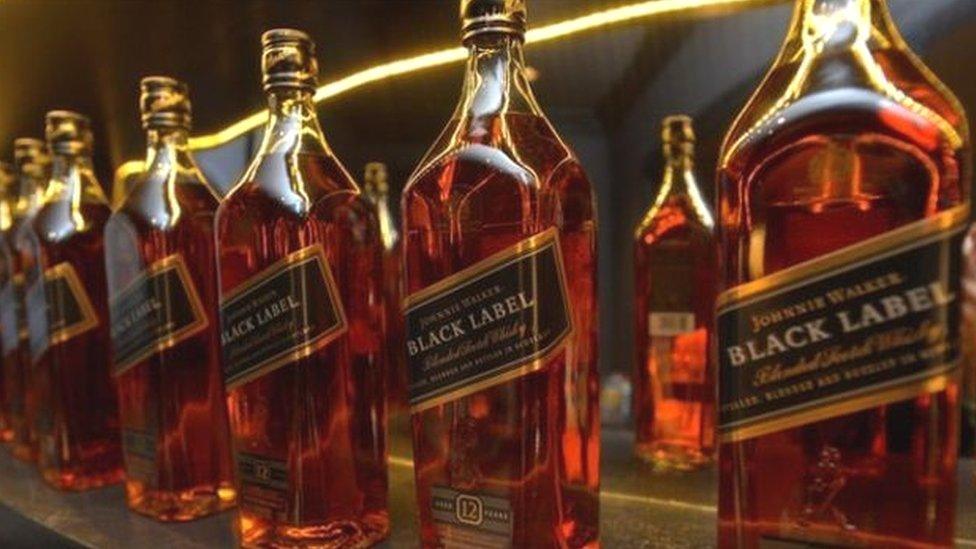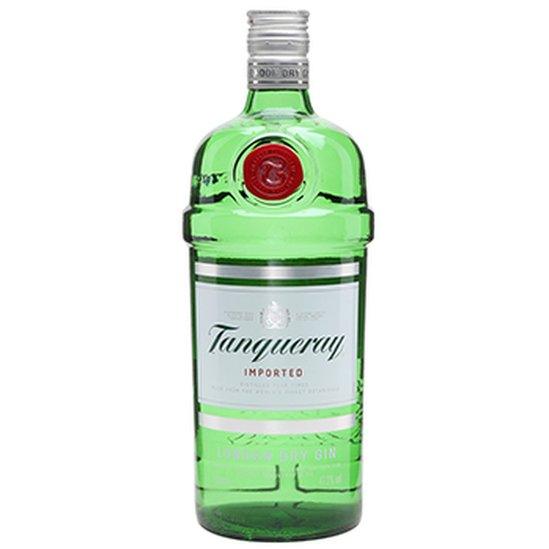Scotch strides: gin fizzes
- Published
Johnnie Walker leads the way on Diageo's Scotch whiskies, but other brands are struggling to keep up.
Its single malt whiskies are doing well in Britain, but rapid global growth has stalled.
The gin craze is putting more variety into the spirit world than even Scotch, and it's now being judged on "cocktail compatibility".
Distillers are watching closely as water levels run low, but say they've prepared.

For Diageo, Scotch whisky matters a lot. It accounts for 25% of sales.
And for Scotch whisky, Diageo matters too. It controls 40% of the industry.
So it's worth paying attention when the London-based distilling giant puts out its annual upsum of the financials and market trends.
With sales above £12bn, and pre-tax profits up 3.7% to £3.7bn, it was presented as a picture of strength and consistency: growth across categories of drink and across continents: of "ongoing rigorous pursuit of execution of our strategy".
The headline numbers beat analyst consensus, and they were accompanied by a £2bn programme of buying back shares.
That's being widely used by companies as a way of driving up the share price by concentrating ownership. It's a reward to shareholders and, of course, to senior executive bonuses. (At the same time, Royal Dutch Shell announced a $25bn share buy-back.) Despite that, the Diageo share price fell 1% on results day. But it's up 25% on the year.
Old Parr
Scotch whisky is a mainstay of the business, and led by Johnnie Walker, it strode on solidly, if unspectacularly.
The company's leading brand is up 5% in the year to June. At least partly, that reflects marketing spend.
Diageo is currently choosing the location for a £120m visitor centre in Edinburgh to promote Johnnie Walker, and lots more to go into four distillery experiences built around the brand, for those who go on the whisky trail round Scotland.
That has led the Scotch "category", while other figures have been a bit less impressive.
The volume of sales was up 2%, and the value was up 3%.
The Black & White brand was also doing well. But other blends, with strengths in particular markets, have lost ground; Old Parr in Colombia, while Windsor suffered a drop of more than 10% due to the continuing decline in the taste for Scotch in South Korea.
J&B has long done well on French supermarket shelves, but it was down last year as well.
'Category contraction'
We've become used to blended Scotch stalling a bit, while single malts have stormed ahead, with premium prices fuelling premium margins.
They went from being a nice-to-have in a distiller's portfolio of whiskies to the key component for growth.
For evidence, go to Edrington's impressive new distillery and visitor centre for Macallan at Craigellachie on Speyside.
But here's the surprise in Diageo's numbers: its range of classic single malts has barely grown at all, up by only 1%.
The company's explanation? "We saw strong growth in some markets like Great Britain and mainland China. However, we saw weakness in Taiwan, arising from commercial challenges and category contraction faced in that market."
So yes, the British market saw 6% growth, led by those single malts. It's a signal that the company may see the value of putting more marketing effort into its home turf.

Tanqueray brands saw global growth of 16%
Botanicals
It might do better still, however, by putting that into gin. It represents merely 4% of Diageo's global sales, but from that low base, Gordon's and Tanqueray brands saw global growth of 16%.
Tequila was up 40%, mainly in North America and Mexico, while Smirnoff vodka and its company variants have been in decline across Europe and North America.
The recent gin craze has encouraged lots of new entrants into distilling, including new Scotch distilleries in need of cash flow while their whisky casks mature.
That is reflected in the latest insights into the spirit world from the International Wine and Spirit Competition, held this week in London.
For the first time, it found more gin entries than Scotch whisky - by 600 to 400. The organisers reckon the global total range is now more than 3500 different distillations, botanicals and expressions.
Driven by millennials, one industry reckoning is that the British thirst for gin could outdo Scotch within only two years. The range of armagnac was also found to be on the rise.
The Worldwide Whiskey Trophy (which did not include Scotch) went to an 18-year old Tullamore Dew from Ireland.
The gin gong went to Scapegrace from New Zealand. And a growing category is for 'cocktail compatibility', judging gins by how well they work with tonic. That's where a German product, Ginstr Stuttgart, came out tops.
If in doubt about the gin craze, check out the latest financial results from Fever Tree. Makers of the premium brand tonic this week revealed a lift in revenue in the first half of this year from £72m to £104m. Adjusted earnings were up 35% to £34m, and the share price continues to fizz.
Life of Water
A final thought on low summer rainfall, for an industry that is all about water. Diageo claims to have prepared for this and is seeing no major problems so far.
After a recent dry summer forced some Islay distilleries to stop production, it has invested in the use of sea water as a coolant on both Islay and Skye.
Chivas Brothers, the second biggest distiller, is watching the River Spey closely - down to its lowest level in at least 34 years.
Environment manager Richard Daalmans points out that many distilleries shut down at this time of year for maintenance, which helps ease the pressure on water courses. And production is often sourced from spring water, which is more reliable than burns and rivers.
But he says there is some concern that a long-run rise in water temperatures will mean more water is needed to have the same cooling effect. A research project is currently under way at The Glenlivet distillery into the implications of that.
- Attribution
- Published20 July 2018
